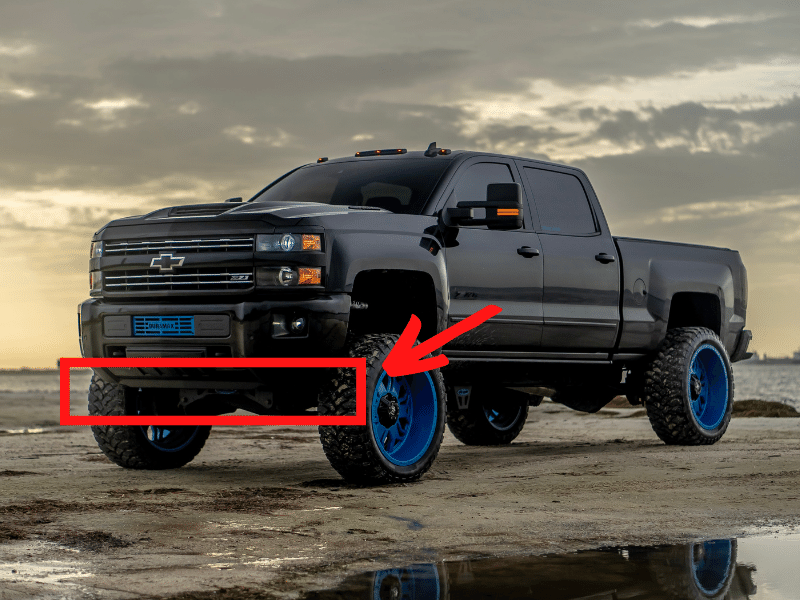The plastic flap under the front bumper of your truck is called a dam. Generally speaking, it is not made of plastic unless it has been replaced at some time by a less expensive aftermarket version of the original.
Table of Contents
Why do trucks have a plastic flap under the front bumper?
Trucks have a plastic flap under the front pumper to create greater traction. The plastic flap under the front bumper is a spoiler. The spoiler presses the nose of a vehicle down at speed to create greater traction. Many production cars have the same thing. What is its purpose? It provides a vehicle, whether it is a car or truck with better stability and ground purchase. Most air dams are just for looks, as they do not serve the purpose they are designed for if the vehicle is traveling at less than 80 miles per hour (128 KPH).

How air dams work
Formula One racing cars have a greater need for air dams than regular production cars as they travel at far greater rates of speed.
At speed, air pressure being generated attempts to lift the car up in the front. Without an air dam, the front wheels would lift off the ground and the driver would lose control.
The function of an air dam can be compared to that of a wing of an airplane attempting takeoff.
Just as the plane has to gain sufficient speed to achieve liftoff, so does a truck need to gain sufficient speed to cause the air dam to have an effect on the truck’s handling performance.
What are air dams made from?
Air dams can also be called spoilers. Lower-priced cars have spoilers made from plastic that look good but do not provide a lot of functionality.
They also break easily on parking barriers and curbs.
The real deal air dams are made from fiberglass or carbon fiber and are expensive to replace if damaged. More money provides better quality and higher performance.
The physics behind air dams
To get an idea of how an air dam works, next time you are a passenger in a car or truck, hold your hand with your palm up right outside the window.
As the vehicle gains speed, your hand will be buffeted by the air around it.
If you flatten your hand so it is pointing forward, then gradually lift your fingers up, you will begin to feel the wind attempting to force you to hand up and if the speed of the vehicle increases, you will have a more difficult time keeping your hand level.
This is where physics comes into play. The air dam is kind of like an upside-down airplane wing.
Where a wing develops negative air pressure on it upper side and creates lift, the air dam creates negative air pressure on its lower side, creating downward pressure.
Does downward force increase speed? Yes, it does. Downward force provides traction. The air around the car is better used and it increases the control over the vehicle.
In addition to air dams, body kits can be added to both cars and trucks to create a more downward force for better high-speed handling.
Other advantages of an air dam
Depending upon the design, an air dam can provide many functions. It can be shaped or positioned to provide better cooling for the engine by deflecting air into the engine compartment.
This can be a very important function in hotter climates.
Trucks such as the Dodge Ram 4500 have a very large engine that generates a great deal of heat.
A great deal of the air diverted by a dam travels through the vehicle’s air intakes, then through the grille and the radiator that sits behind it, and into the engine compartment.
This air helps keep the engine cool. This is important as an engine running overheated is not running efficiently.
High heat can also damage the engine.
Some of the airflow also travels over the top of the vehicle cabin, providing an additional downward force at speed.
Disadvantages of an air dam
While air dams have many advantages, they also have some disadvantages.
Race cars including formula One travel on smooth tracks and can have their air dams located very close to the ground.
Personal cars and trucks often hit or nudge bumper blocks in a parking lot.
Curbs and similar obstacles can have a very negative effect on an air dam that is fitted too low.
If the air dam on your vehicle was sitting just a few inches above the ground, your high-speed handling on a freeway would be great.
However, when you come off the freeway onto a lumpy street with potholes, your dam could suffer.
The same if you used your truck for a lot of backcountry travel, a low-slung air dam would be one of the first casualties when you hit a boulder when crossing a stream, for example.
Aftermarket air dams
While the factory air dam that comes with your truck may be very satisfactory, if the best performance is your goal, you may want to explore the after-market dams available.
The aftermarket manufacturers want your business and will put a lot more into testing and refining their products than the OEMs do.
If money is no object, there are many choices at your disposal in the aftermarket range of air dams.
Frequently Asked Questions About Why Do Trucks Have A Plastic Flap Under The Front Bumper
Does the air dam provide better cornering in my truck?
If you remove the air dam from your truck, you will notice decreased handling control on cornering at high speeds. At low speeds, you would not notice a difference.
The air dam on my truck has a big ding from a collision with a rock. Will this affect my truck’s performance?
A dinged or bent air dam will only affect your truck’s high-speed performance. If you do a lot of freeway driving, you will notice differences both in handling and fuel consumption.

